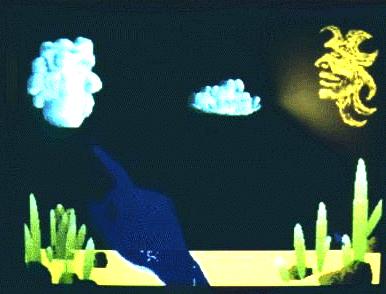The Venus Project was formed in the spring of 1989 as an independent cyberart coalition whose members embraced the techno-aesthetic philosophy of a positive human/computer synergy. The expression of this philosophy was the use of technology in playful, educational opportunities for interaction shared with others. The Venus Project members included Bob Nagy, Karen Pittman and John Witham.
VP-1, the first public exhibit designed by the Venus Project, appeared at RoboFest (1989 show at Discovery Hall in Austin, TX).
The exhibit was a computer-mediated interactive environment for producing musical sounds by body movements and for manipulating computer graphics with those sounds.
The participant donned a helmet that actuated MIDI-controlled synthesizer sound module. Pressure-sensitive areas beneath the feet of the participant were also connected to the sound module.
The graphics display was driven by software that changed the output based on the audio pitches and the interrelation of the audio signals.
VP-2 (Sonic Silhouette), the second Venus Project work designed for exhibit at Discovery Hall, was featured in RoboFest 2 (February 1991)
In this installation, body movements were tracked by an overhead video camera and digitized. A graphical interface to the audio synthesizers, in the form of a grid, caused musical sounds to be produced.
This system acted like a virtual instrument that was played by dancing or moving inside the digitized space.
VP-3 (Musicgraphic Hyperinstrument), was designed for the Berzerkwerks installation at the Austin Children’s Museum (August 1991).
This exhibit featured several virtual worlds that the participant could “enter” through the video camera and digitizer.
These worlds, created using the Mandala System authoring software, enabled the user to create sounds, trigger animations, and to paint by moving and “touching” virtual objects.
Lights and fans in the room surrounding the exhibit were also activated by these virtual objects and acted on wind sculptures and other installations in the show.
This exhibit was modified and renamed Video Playscape and remained on display at the museum after the close of the Berzerkwerks show.
Iterations of this exhibit were the top interactive attraction at RoboFests.

VP-4 (Living Systems Interactive Video Environment / L.I.V.E.)
In February 1992, the Austin Childrens’ Museum commissioned the Venus Project artists to create a virtual representation of the human digestive system.
The Mandala System was used to design scenes for the Video Playscape which made an educational game of the process of digestion. It featured an interactive tour of the digestive tract with animations, sound samples, and music.
VP-5 (Performance Interfaces) emerged in April – May 1992. The Venus Project designed and performed with several new virtual interfaces for control of audio synthesizers accompanied by the Sainsott’s Shrinking Robot Heads Band.
The debut performance for the combined organic and inorganic groups was held at X/XX2 Experimental Musical Festival on April 4, 1992. The performance featured an ensemble of six live (organic) musicians as well as the Shrinking Robot Heads Band members.
The interface was used to play synthesizers as the performers moved inside a digitized space.
Venus Project interfaces were also designed to be used in performance at Mayfest in Tulsa, OK and at RoboFest 3 in Austin that year. In both of these events, the interfaces were also to be used experimentally by the audience.